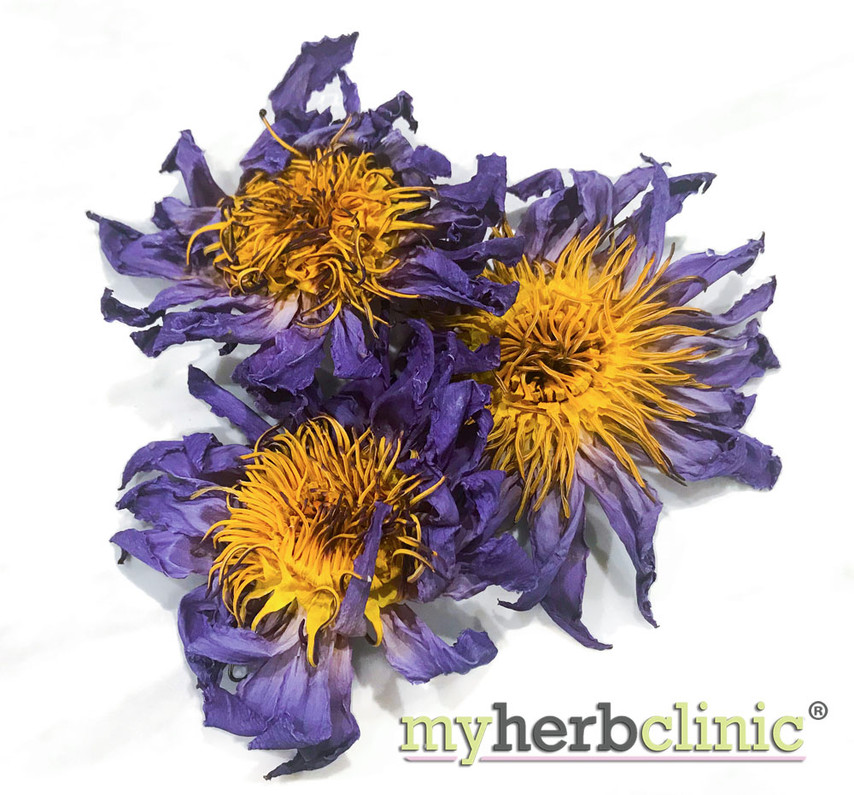Get mellow with Blue Lotus
What is Blue Lotus?
Blue Lotus grows in ponds with the magnificent flower floating on the surface, showing the glorious colour to the world. It is known by the common names Blue Lotus, Egyptian Lily or Waterlily, and Sacred Blue Lily, however the correct name is the scientific or botanical name, Nymphaea caerulea. The caerulea in the name refers specifically to the blue colour of this lotus, and lotus of other colours, such as red and white, have different botanical names and a different balance of natural chemical constituents. It has a long historical use, with an association with Queen Cleopatra VII of ancient Egypt, and has been found documented on papyrus.
How is Blue Lotus used?
Traditionally it has been used as a tea, added to baths, smoked, used as incense or potpourri. The main non-toxic alkaloid constituents identified in this plant are nuciferine, nornuciferine, and roemerine, and possibly apomorphine (though sources are inconsistent on this or the similar aporphine) which bind to dopamine D2 receptors, and can increase Oxytocin, and these may contribute to the popular use of Blue Lotus for pain relief and muscle relaxation, inducing a mild state of euphoria, and as an aphrodisiac or for impotence.
The alkaloids do not extract particularly well into water, so a tea may not provide the full effect of the alkaloids from Blue Lotus, though you will get some from a hot water infusion. Naturopaths and herbalists will use alcohol extracts to create tinctures for herbs like this, as alcohol will extract the constituents much better than other mediums in these situations. This may also be why there is also a strong history of use as a smoking herb.
Blue Lotus has also been analysed for the antioxidant constituents, and 9 active compounds were isolated, including a form of Quercetin.
Compared to herbs like St Johns Wort and Echinacea, Blue Lotus is not well researched at all, so information is incredibly limited, and traditional uses not well established through scientific research. However there is a wealth of anecdotal evidence from individuals utilising the herb for psychoactive or euphoric effects, to improve their love life, whether that is for the aphrodisiac action, or to improve effects of impotence, and to alleviate anxiety.
In more modern history Blue Lotus is also available as an essential oil absolute, and it certainly smells intoxicating! Whether you like to enjoy the Blue Lotus whole or crushed flower, or pop some essential oil into a diffuser or beauty product, one thing is for sure, it really is a magical flower in looks, scent and chemical makeup.
Recent Posts
-
Essential Oils for Winter Diffusers: Clear, Calm, and Cosy Scents
Essential Oils for Winter Diffusers: Clear, Calm, and Cosy Scents Winter invites us to slow down, re …25th Jun 2025 -
Top 7 Herbal Teas to Keep You Warm and Nourished This Winter
Top 7 Herbal Teas to Keep You Warm and Nourished This Winter As the temperatures drop across Austral …25th Jun 2025 -
Chai Poached Pears: A Simple, Spiced Delight
When it comes to easy yet elegant desserts, Chai Poached Pears are a timeless favourite. This recipe …18th Jun 2025




